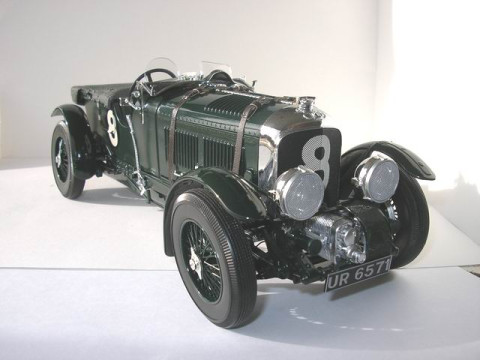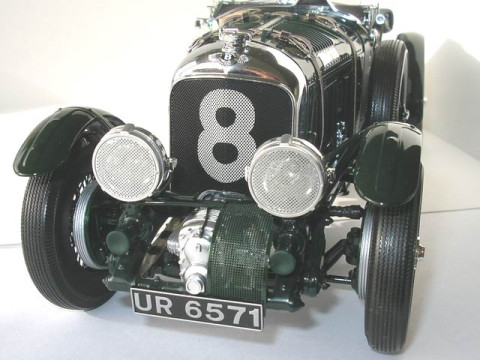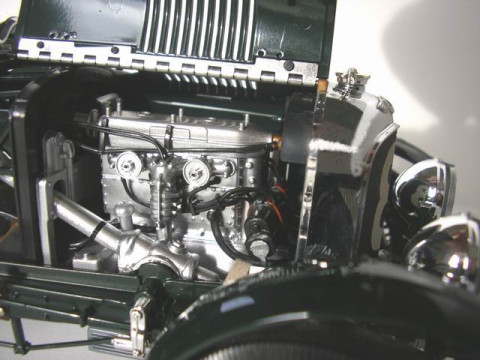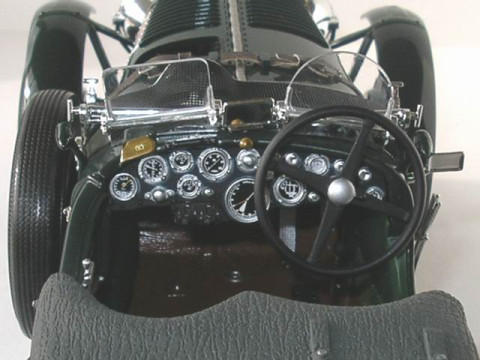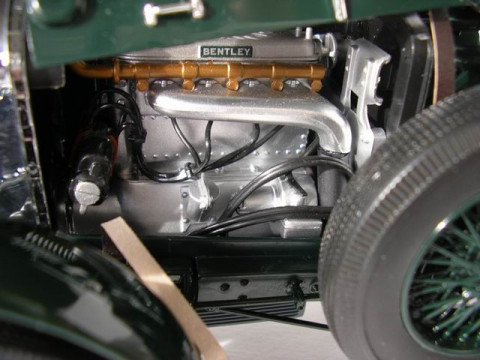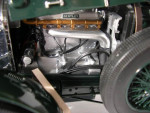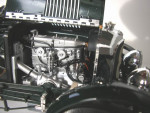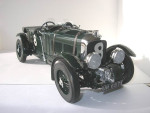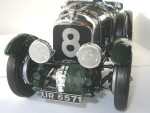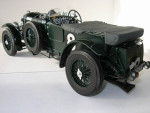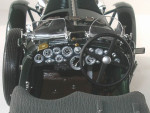I have a new favourite model!! It had to happen one day I suppose. I wasn’t looking for it - it just happened. I mean, it doesn’t even fit any of my themes!! It’s a Vintage Race Car and I don’t collect Vintage Race Cars or even Vintage-any-Cars. I collect Australian Muscle Cars, Jaguars, Toyotas and Rally Cars and it doesn’t fit any of those groups (I suppose Rally Cars could be Race Cars). So how did it happen? Well – it just did!! But I’m sure I’m not the only one who’s succumbed to the temptation of acquiring a model just because it appeals to the eye, or to the sense of hopeless desperation we, who are of a certain affliction, have all felt at one time or another!!.
This model is the Minichamps rendition of the famous 1930’s Le Mans 4.5 Litre Bentley Blower in 1:18 scale, and is one of the best detailed models I’ve seen in a long time. The history of these great cars has been covered ‘chapter & volume’ over many years, on many occasions, and I have no intention to write another one, but rather a very brief summary on which were, very famous, fast and esteemed cars in their day.
After Bentleys won Le Mans in 1928, 1929 and 1930, in normally aspirated cars, a certain Tim Birkin of the famous ‘Bentley Boys’ racing team approached W.O Bentley and asked him to consider supercharging as a way to produce even more powerful and faster versions of the winning cars. Bentley was not enthusiastic as he believed bigger capacity was the key to more speed, hence the appearance of the 6.5 Litre & even 8.0 Litre versions later on. However, Birkin was persistent and eventually was able to persuade Bentley, who reluctantly allowed him to proceed. The irony of all this was borne out on the race track, as the supercharged cars never actually won Le Mans, or any major race for that matter!! However, the cars remained in the guise we see now, and are an imposing sight. In fact, it is these cars another gentleman, a Mr. Ettore Bugatti referred to as ‘The Fastest Lorries in the World’, in reference to the sheer bulk and stance of these legendary beasts. With genuine cars selling nowadays for many millions of dollars each, we mere mortals can console ourselves, and thank companies like Minichamps for the existence of gorgeous copies like the one you see here.
This first thing you notice when seeing this piece of modelling art is the size of it. I deliberately parked my Le Mans Jaguar C-Type (incidentally – the same shade of British Racing Green) next to it and was surprised to see the bonnet of the Jaguar only came up to the height of the Bentley’s tyre!! What was I saying about Lorries? But that can only mean one thing, the bigger the model the more detail that can be crammed onto it, and the Bentley certainly does not disappoint.
As can be expected on a model of this quality, paint and finish are magnificent, accurately depicting the bright shiny paint on the front and bonnet and the duller paint of the rest of the body. It must be remembered that from the scuttle/windscreen back these cars were canvas-over-wood bodied. It seems a false economy that these bodies were put on to save weight, seeing as the cars were weighing in at just on two tons; it all seems a bit futile!!
Starting at the front you are immediately confronted by an array of mechanical wizardry, namely the supercharger, the mesh guard covering the carburettors, the huge headlamps and the magnificent chromed radiator cowling – also all mesh covered. Of course, the radiator cowling wouldn’t be complete without the obligatory Bentley ‘Flying Wings’ emblem which is prominently displayed. The mesh appears to be photo-etched, is very fine and appears to be a little out of scale, although it would be hard to prove as I haven’t any way of measuring it!! The bonnet assembly, featuring nice chrome locks and handles, and a heap of louvres and vent holes, is side opening on each side and both halves are double folding, and held shut by real leather strapping. These are released by using tweezers to undo wire buckles – four in total, thus revealing the engine bay. As expected the engine, a 4 cyl. SOHC, 4 valves per cylinder, twin spark plug unit - is fully wired and plumbed, showing all ancillaries including the twin magnetos.
Moving further back we find the twin aero-screens. These are both able to be positioned as is a mesh stone guard which lies flat but is raised to allow access to a remote oil filler – to save time undoing bonnet straps while racing. The passenger compartment has two doors, one on the left hand front and the other on the right hand rear. The drivers front door doesn’t exist, as an opening there would have interfered with the drivers access to the handbrake on the outside and the gear shift on the inside. The rear passenger compartment is covered by a tonneau cover, which is there in place of a fold up roof, but is removable to reveal a rather spartan area which may have held luggage or a passenger for a little way only, there being no rear seat.
At the rear we come to the fuel tank. On the road cars this would have been of 70 litre capacity, but the race cars had a massive 200 litre tank. This was not to provide for less fuel stops during the 24 hour Le Mans race, but to cater for the cars insatiable thirst for fuel – a staggering 2 miles per gallon!! (That’s nearly 1 km per litre!!) I wonder how the environmentalists would tolerate that today?
Looking around and underneath the car we can see the usual array of driveline and suspension components all detailed to the same high standards. Of particular note are the fabulous, body coloured wire wheels with knock-off spinners (also showing the Bentley name), and big balloon tyres, all covered by ‘cycle’ type mudguards. Don’t forget the side mounted spare wheel, the well cast brake drums – on all four wheels, and also present is the proper ‘fish-tail’ exhaust. The front wheels turn with the 4-spoke steering wheel via the proper steering rods as seen on the right hand front chassis rail.
Finally, we find the control centre – the cockpit. Here there is a huge array of dials, gauges and switches bearing in mind that in 1930 a Ford Model A would have barely had a speedo and a fuel gauge, never mind enough instruments for a light aircraft!! The largest one is the Rev Counter, and although the numerals are too small to read, the calibrations, change-up zone, needle and ‘red line’ can be seen. Also visible are the foot pedals which, as was the ‘norm’ in those days, the accelerator is in the middle. Wooden floorboards are painted in and the bucket seats show a nice patina, as though they’ve seen good use over the years.
There is no doubt this is a superb model. Some have said perhaps this Minichamps’ best ever model!! But ones thing’s for sure – I know I’m never likely to see the real thing, so I’m very proud to have this fantastic replica take up some shelf space in my display cabinet.
Gallery
Shayne Spicer
© 2009
